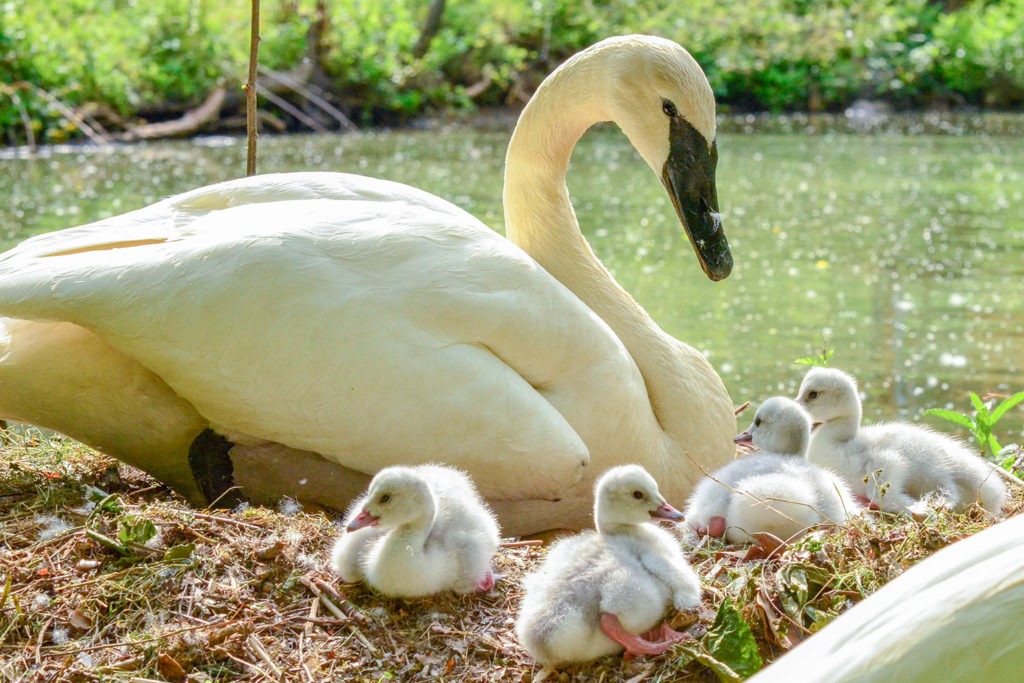Overview
“Where I live”
Trumpeter swans once nested across most of North America but are now found only in isolated areas of the northwest and north-central regions of the continent. They are native to both the United States and Canada. Biologists currently recognize three distinct populations: the Pacific Coast population, the Rocky Mountain population, and the Interior population.
“How I live there”
Trumpeter swans are long-lived, social birds that thrive in quiet areas of open water free from human disturbance. They inhabit lakes, ponds, rivers, and coastal bays and seek out tidal mudflats during the winter. They are well adapted to the sometimes harsh environments in which they live. An extremely dense layer of down makes them very tolerant of cold conditions.
Active during the day, trumpeter swans feed mainly on aquatic plants. They forage on land as well during the winter. For the first few weeks of life, cygnets (swan chicks) feed primarily on insects and other invertebrates but then transition to a plant-based diet.
Trumpeter swans put their long necks and strong feet to good use uprooting aquatic plants growing in water up to four feet deep. By pumping their back feet, the birds create a current that helps dislodge plant roots from surrounding mud. By dipping their necks well below water, they can get a good grip on plants and dislodge them.
“Making my mark”
Trumpeter swans are large and majestic birds with white feathers, black bills, and long, straight necks. They are sometimes mistaken for tundra swans, another species native to North America. Trumpeter swans are much larger, though, and can be identified by their deep, resonant, trumpet-like call.
Want to impress your friends? Know your swan vocabulary! A male swan is called a cob, a female is a pen, and a baby swan is a cygnet.
Raising Young
Trumpeter swans form pair bonds when they are 3 or 4 years old and typically stay with the same mate for life. They arrive at their breeding grounds together, often before ice has fully melted. Pairs engage in courtship behaviors for several days before choosing a site for nest building. Most pairs will return to their previous nest site if possible and simply repair and add to last year’s nest.
Trumpeter swans tend to nest in freshwater marshes and other shallow wetlands where they can find plenty of nesting material and cover, as well as a rich supply of food. They build massive nests from aquatic vegetation, grasses, and sedges. Males gather the nesting materials and females do the building, often atop an elevated site that is surrounded by water such as a beaver lodge or small island. Each nest is a large mound with a depression in the center, lined with feathers and down. A typical nest can measure up to five feet across and weigh hundreds of pounds!
A female trumpeter swan lays 4 to 6 eggs and incubates them for approximately 32 days until the cygnets hatch out. She will leave the nest only occasionally to feed, bathe, and preen her feathers. During incubation, the male guards the nest from predators. Within 24 hours of hatching, cygnets are able to swim and feed themselves. Parents stay close and lead them to good feeding areas.
Interestingly, female trumpeter swans begin to moult at about the time that their chicks hatch out. Females remain flightless for approximately one month, during which time they tend to their chicks. Just as they get their new flight feathers, males begin to moult. Staggered moult cycles insure that at least one parent remains “grounded” with the chicks until they fledge, which occurs about two months after hatching.
“What eats me”
Adult trumpeter swans have few natural predators but there are many animals that will seize eggs and chicks, including eagles, owls, coyotes, mink, otters, and ravens.
Conservation
Trumpeter swans once lived across North America from the Pacific to the Atlantic. With the arrival of European settlers, though, the species was hunted to near extinction. Historically, these birds were prized for their skin and feathers, which were used to decorate hats and to make quill pens. By the 1930s, trumpeter swans had almost vanished from North America. They were granted protective status under the Migratory Bird Treaty Act of 1918, which is recognized by both the United States and Canada. With protective status, they have made a remarkable comeback. Populations are expanding and the species is now considered one of “least concern” by the IUCN, the world’s leading conservation organization.
Today, trumpeter swans are threatened mainly by habitat loss due to ongoing destruction and degradation of wetlands. Concerted efforts are being made in the United States and Canada to reintroduce the birds to many parts of their original range, and these efforts include preserving and protecting favorable habitat.
It is illegal to kill trumpeter swans in any part of their range, but they are sometimes shot accidentally when mistaken for tundra swans or snow geese (which are legal game in some areas). Trumpeter swans can also fall victim to collisions with power lines and to lead poisoning resulting from accidental ingestion of lead shot or fishing sinkers.
Taxonomy
- Kingdom: Animalia
- Phylum: Chordata
- Subphylum: Vertebrata
- Class: Aves
- Order: Anseriformes
- Family: Anatidae
- Genera: Cygnus
- Species: buccinator


